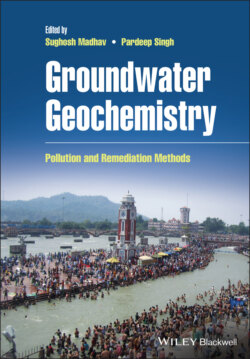Читать книгу Groundwater Geochemistry - Группа авторов - Страница 62
2.5.3.7 Electrocoagulation
ОглавлениеElectrocoagulation (EC) is another filtration method removing suspended solids (fluorides) to μm level from water (Noling 2004). Electrocoagulation is a type of electrolytic method in which metallic cation synthesis occurs at sacrificial anodes (Kobya et al. 2016). The electrocoagulation utilization has been enhanced in the last decade. This method is introduced as one of the suitable methods for elimination of fluoride from contaminated drinking water. It can effectively remove a wide range of pollutants such as oil, heavy metals, dye, and fluoride (Hu et al. 2005; Malakootian et al. 2011). The electrocoagulation method does not release secondary pollutants and retain beneficial components of raw water during defluoridation. According to the report of Sinha et al. (2012), the electrocoagulation successfully eliminates fluoride and aluminum simultaneously under the condition of 230 V DC using aluminum electrodes. Better fluoride removal from drinking water can be achieved by providing longer retention time. One of the most important parameters in this method is charge loading for controlling EC reaction rates that ultimately decides coagulation rates (Kobya et al. 2016). The fluoride depletion and charge loading performance do not have a linear relationship. Despite being the important parameter for EC, charge loading is not considered a critical parameter in fluoride removal from drinking water. Enhanced charge loading reduces fluoride concentration initially in treated water, whereas after a critical point the fluoride concentration decrease was not significant (Sinha et al. 2012). The electrocoagulation method releases less aluminum from water in comparison to the active aluminum process and the Nalgonda technique. Data revealed that aluminum concentration in treated water is enhanced when input energy has been enhanced (Sinha et al. 2012). From steel industry wastewater, successful removal of fluoride has been done using the electrocoagulation method. The fluoride removal has been optimized under several conditions like “hydraulic retention time, pH, temperature, voltage, number of aluminum plates between anode and cathode to assess the performance of this method. Results revealed that increase in hydraulic retention time by 5 min shows enhanced fluoride removal performance”. The concentration of fluoride reduces from 4 to 6 mg/L to less than 0.5 mg/L (Khatibikamal et al. 2010). According to the study of Emamjomeh and Sivakumar (2006) the performance of fluoride removal depends upon various parameters like current density, initial concentration of fluoride, flow rate of wastewater, and pH. The fluoride removal is directly related to aluminum F− hydroxide complex [AlnFm(OH)3n−m] formation during electrocoagulation (Emamjomeh et al. 2011).
